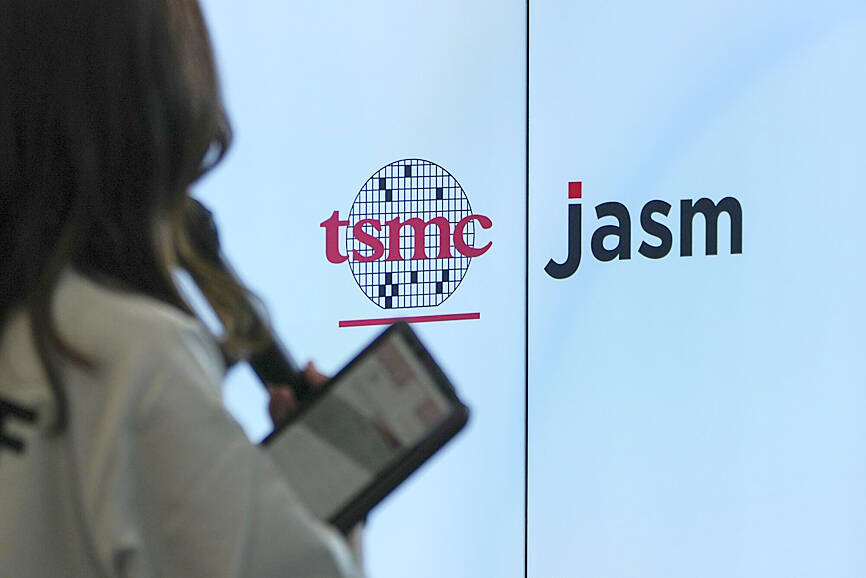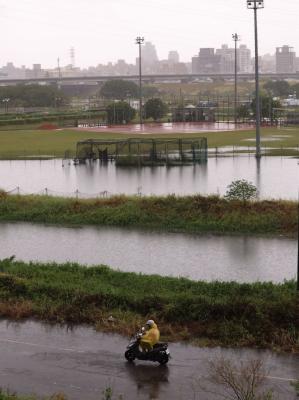The expansion of chipmaking giant Taiwan Semiconductor Manufacturing Co (TSMC) in Japan should cement its lead over peers in the global semiconductor market while providing a major boost to Japan’s chip infrastructure, analysts said.
“TSMC is ahead of its rivals to invest in Japan, further strengthening its leadership status,” said Ray Yang (楊瑞臨), a consulting director at the government-sponsored Industrial Technology Research Institute.
TSMC’s well-established production, research and development hubs in Taiwan have helped the firm leave Intel Corp and Samsung Electronics Corp behind in the global pure-play wafer foundry industry, he said.

Photo: Bloomberg
Adding a production hub could build on that advantage, he said.
“I expect the investments in Japan will strengthen resilience of TSMC’s supply chain and become a strategic part of the chipmaker’s global expansion,” he added.
Yang said that while production costs in Japan are higher than in Taiwan, they are lower than in Europe and the US.
In addition, Japan already has a complete supply chain that can meet TSMC’s needs, and the two fabs should ease clients’ concerns over political tensions across the Taiwan Strait, Yang said.
TSMC officially opened its first fab in Kumamoto in southern Japan yesterday afternoon under a joint venture called Japan Advanced Semiconductor Manufacturing (JASM), with commercial production scheduled to begin in the fourth quarter.
TSMC on Feb. 6 said JASM, which is owned by TSMC and Japanese partners Sony Semiconductor Solutions Corp (SSS) and Denso Corp, are to build a second fab in Kumamoto.
Construction is slated to begin at the end of this year, with operations scheduled to start at the end of 2027.
TSMC said Japanese auto giant Toyota is to take a minority stake in the joint venture, with TSMC holding an 86.5 percent stake in JASM, while SSS, Denso and Toyota are to hold a 6 percent, 5.5 percent and 2 percent stake respectively.
The overall investment of JASM is to exceed US$20 billion to roll out chips using TSMC’s mature 40-nanometer, 28-nanometer, 22-nanometer, 16-nanometer and 12-nanometer processes, as well as the advanced 7-nanometer and 6-nanometer technologies.
TSMC’s competitors are unlikely to venture into the Japanese market, Yang said.
Intel has decided to expand its production capacity in Israel and Ireland, and it is building a new plant in Germany, which makes it likely to be too busy to diversify further and set up an advanced wafer fab in Japan in the foreseeable future, Yang said.
As for Samsung, it has focused on manufacturing in South Korea and the US, he said, adding that he doubted Samsung would open a new fab in Japan given the animosity between South Korea and Japan.
Liu Pei-chen (劉佩真), a researcher at the Taiwan Industry Economics Database of the Taiwan Institute of Economic Research, said that TSMC has made impressive progress and opened its first fab in Kumamoto relatively quickly.
While TSMC began working on its first fab in Arizona about a year before the construction in Kumamoto was launched, the Arizona fab is not expected to start commercial production before next year, a year behind schedule.
“The progress in the Kumamoto fab demonstrated the Japanese government’s ambition to strengthen its semiconductor industry by quickly providing mass subsidies [to JASM],” Liu said.
Media reports in Japan said that investment in the first Kumamoto plant was about ¥1.1 trillion (US$7.31 billion), and the subsidies provided by the Japanese government accounted for almost half of the amount.
TSMC also set up the TSMC Japan 3DIC R&D Center in March 2021. The subsidiary, in the Tsukuba Center of the National Institute of Advanced Industrial Science and Technology, is to develop high-end integrated circuit packaging and testing services and provide one-stop services to clients.
Liu said that while Japan cannot catch up with the US, South Korea and Taiwan any time soon in terms of global market share, TSMC’s presence in Kumamoto is expected to advance the nation’s status in the global semiconductor world.
Japan is focused on mature semiconductor production and it is taking about a 3 percent share in the global market, Taipei-based information advisory firm TrendForce Corp said.
It said Japan is expected to maintain a 3 percent share in global mature processes below the 28-nanometer process and secure a 4 percent share in processes more advanced than 16-nanometer technology in 2027.

TRAFFIC SAFETY RULES: A positive result in a drug test would result in a two-year license suspension for the driver and vehicle, and a fine of up to NT$180,000 The Ministry of Transportation and Communications is to authorize police to conduct roadside saliva tests by the end of the year to deter people from driving while under the influence of narcotics, it said yesterday. The ministry last month unveiled a draft of amended regulations governing traffic safety rules and penalties, which included provisions empowering police to conduct mandatory saliva tests on drivers. While currently rules authorize police to use oral fluid testing kits for signs of drug use, they do not establish penalties for noncompliance or operating procedures for officers to follow, the ministry said. The proposed changes to the regulations require

Taipei, New Taipei City, Keelung and Taoyuan would issue a decision at 8pm on whether to cancel work and school tomorrow due to forecasted heavy rain, Keelung Mayor Hsieh Kuo-liang (謝國樑) said today. Hsieh told reporters that absent some pressing reason, the four northern cities would announce the decision jointly at 8pm. Keelung is expected to receive between 300mm and 490mm of rain in the period from 2pm today through 2pm tomorrow, Central Weather Administration data showed. Keelung City Government regulations stipulate that school and work can be canceled if rain totals in mountainous or low-elevation areas are forecast to exceed 350mm in

The Executive Yuan yesterday announced that registration for a one-time universal NT$10,000 cash handout to help people in Taiwan survive US tariffs and inflation would start on Nov. 5, with payouts available as early as Nov. 12. Who is eligible for the handout? Registered Taiwanese nationals are eligible, including those born in Taiwan before April 30 next year with a birth certificate. Non-registered nationals with residence permits, foreign permanent residents and foreign spouses of Taiwanese citizens with residence permits also qualify for the handouts. For people who meet the eligibility requirements, but passed away between yesterday and April 30 next year, surviving family members

1.4nm WAFERS: While TSMC is gearing up to expand its overseas production, it would also continue to invest in Taiwan, company chairman and CEO C.C. Wei said Taiwan Semiconductor Manufacturing Co (TSMC) has applied for permission to construct a new plant in the Central Taiwan Science Park (中部科學園區), which it would use for the production of new high-speed wafers, the National Science and Technology Council said yesterday. The council, which supervises three major science parks in Taiwan, confirmed that the Central Taiwan Science Park Bureau had received an application on Friday from TSMC, the world’s largest contract chipmaker, to commence work on the new A14 fab. A14 technology, a 1.4 nanometer (nm) process, is designed to drive artificial intelligence transformation by enabling faster computing and greater power